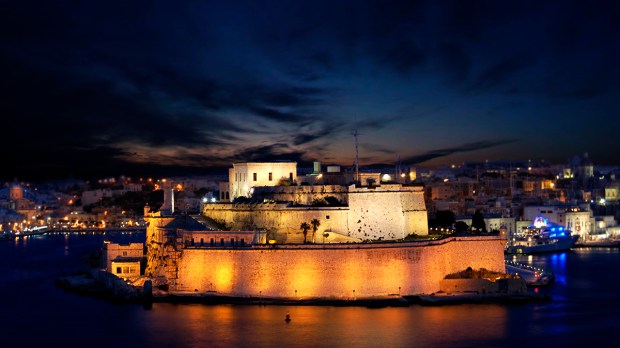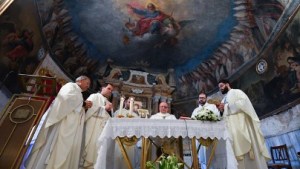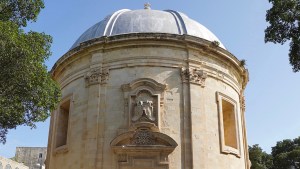In the first part of this article, we explained how the history of Malta is deeply intertwined with its relatively soft rock formations and its limestone caves. Early Christians living in the archipelago turned caves and pre-existing catacombs into chapels that could accommodate a growing community of believers, resulting in a series of churches that appear to have formed naturally out of the beautiful Maltese underground landscape. As explained by Dr. Charlene Vella to the website Guidememalta.com (the Department of Art and Art History at the University of Malta), cave churches also took a symbolic meaning as they were seen as a “figuration of the Entombment and Resurrection” of Jesus Christ.
Often, it was hermit-monks who discovered suitable natural enclaves for prayer and meditation, which were later used by Christians as places of worship. Sometimes, when local parish communities experienced fast growth, cave churches were annexed to existing catacombs built by the early Christian community way back, when Christian burials were not allowed within the city walls.
In our previous piece, we featured six Maltese churches from the 4th to the 15th century. In this one, we want to list seven more.This list is certainly not exhaustive, as there are other existing cave churches, and others that are documented but unfortunately have been completely lost. Also, it is beyond doubt that in Malta and Gozo there are several other cavern churches buried under the ground or hewn deep in the hillsides of our steep valleys. The rock formations in the islands are mostly of globigerina limestone, soft and easy to burrow, and caves and caverns are common in such geological environment. To unearth or discover some of these is a long and arduous task. However, we have faith that in the future more cave churches and subterranean treasures will be discovered.
We would like to thank Prof. Stanley Fiorini who patiently and kindly assisted us to write this article
1. Saint Mary Magdalene
This circular cave church, featuring a bench carved out of limestone, is the only surviving example of a series of cave churches that were once found in this part of Rabat. Its crypt-like appearance is owed to the fact that this was once a catacomb that was eventually turned into a chapel. The church is reached down by a flight of steps with walls that are stuccoed with a cement mixture of ground pottery and lime, perhaps intended for paintings, of which no evidence survives. Similar to other cave churches, St. Mary Magdalene is connected to and once served as an early Christian catacomb.
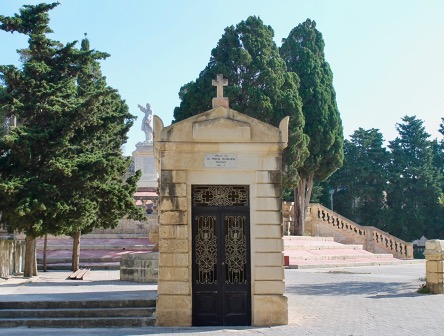
“Church of St. Mary Magdalene – Penitent – IV century”
| Courtesy of Martha Borg
Mgr. Pietro Dusina’s report of 1575 records that it was used as an ossuary for the cemetery above it, as well as having a mural that was meant to be a terrifying reminder of death. In 1647, Gian Francesco Abela noted and recorded an “innumerabile quantità di ossa” (innumerable quantity of bones) as well as rubble in the church.
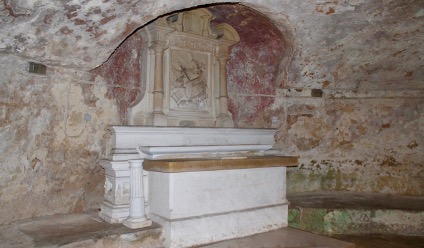
Abela G. F. “Della Descrittione di Malta Isola Nel Mare Siciliano Con le Sve Anthichita, ed Altre Notitie” In Malta per Paolo Boncato. 1647
Borg M. The Cave Churches in Malta and their Paintings: An Art Historical Gazetteer. Dissertation for a Degree of Bachelor of Arts (Hons.) in History of Art. (Faculty of Arts. University of Malta). June 2014
2. The Sanctuary of Our Lady of the Grotto in Rabat
Around the year 1400, the Virgin Mary is said to have appeared to a hunter in a cave. In a short time, the cave became a chapel, and then a church, and then a priory. Through the centuries, the devotion of the Maltese to their Madonna of the Grotto never faltered. Devotion to Our Lady of the Grotto gathered momentum when, around 1450, three Dominican friars from the Sicilian Province founded the Order in Malta and requested to be given the cave where the Blessed Virgin appeared. Over the centuries all sorts of graces were granted through the intercession of Our Lady of the Grotto. Only volumes can include them all. In Our Lady of the Grotto Weeps Tears of Blood (by Fr. Michael Fsadni O.P.), we can find a repertoire of graces granted and amazing events – healings, lifting of plagues, protection of children and pregnancies, and the list goes on. The most recent extraordinary happening is that of the statue of the Madonna weeping blood.
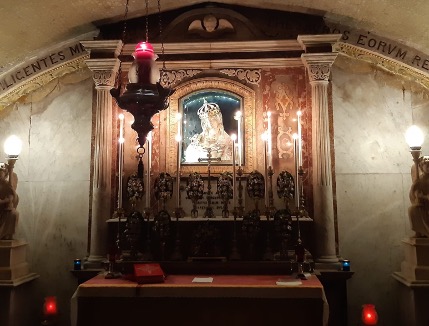
On May 6, 1999, devotees noticed red liquid trickling down the cheeks of Our Lady’s image. They expeditiously notified the Dominican Superiors. When the Archbishop of Malta was informed, at the time Mgr. Paul Cremona, he immediately commissioned an inquiry under the supervision of the Vatican’s Congregation for the Doctrine of the Faith (CDF). This also included forensic studies. On December 12, 2003, The Archbishop’s Curia issued a press release in which it was recommended that the members of the Church should keep alive and strengthen their traditional love for Our Lady, and that in the light of the report by the experts, and advice of the CDF, it would be worthwhile that this love of the Maltese towards the Madonna continues to embrace, in a worthy and authentic manner, the age-old devotion towards the image of Our Lady of the Grotto.
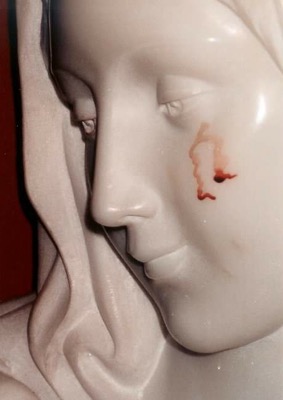
Fsadni M. Our Lady of the Grotto Weeps Tears of Blood. Priory of Our Lady of the Grotto Rabat, Malta. 2005
3. Our Lady of Virtue (Santa Marija tal-Virtù)
The Santa Marija tal-Virtù site, in the easternmost extremity of the Rabat plateau, has archaeological significance and is rich in Phoenician and Romano-Punic tombs, some of which have yielded important finds. One such find was a paleo-Christian hypogeum, which seems to have consisted, rather uncharacteristically, of locular graves. The hypogeum most likely dates from the end of the 5th or the beginning of the 6th centuries. Seventeenth- and 20th-century historians associated it with a rock-cut crypt, beneath the Rotunda church of tal-Virtù, which was possibly formed by the recutting and fusion of several burial chambers of the hypogeum. The crypt has a lobed plan roughly resembling a Latin cross with three apsed recesses. All around it ran rock-cut benches, and the walls were stuccoed to make them waterproof and, possibly, to receive murals.
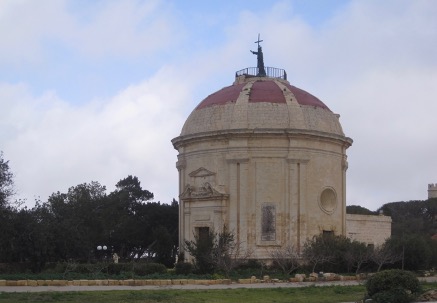
| By NickGeorge1993 – Own work, CC BY-SA 4.0 (cropped)
Two pilasters supported the ceiling and light was filtered through two skylights. The facade of built masonry is stylistically datable to the 15th century. It has a low, slightly pointed, arched doorway with large voussoirs round which runs a Gothic dripstone with end rosettes which is beautifully decorated with acanthus leaves. Both voussoirs and jambs have relief carvings of zig-zag patterns between which leaves meander and intertwine. The crypt is reached down through several steps, and accounts from 16th-century apostolic visits indicate it had several altars. However, only one altar is mentioned in subsequent reports and in Gian Francesco Abela’s 1647 Description of Malta. A church seems to have been built above the crypt by 1438. The decision to replace the old church by the rotunda, standing today, was apparently taken around 1717. The rotunda, which was a very popular shrine, was modeled on the 1678 Sarria rotunda at Floriana, dedicated to the Immaculate Conception.
Buhagiar M. The Crypt and Church of S. Marija tal- Virtù at Rabat. A Journal of Maltese History. 1979. (accessed in January 2021)
4. St. Leonard in Wied Liemu (San Anard ta’ Wied Liemu)
St. Leonard the Hermit was a Latin saint whose veneration was highly notable in Norman Sicily, and was quickly adopted by the Greek-rite element. The saint’s cult was introduced to Malta by the Normans. The cave church of St. Leonard in Wied Liemu (or Wied il-Lunzjata – Valley of the Annunciation), found within the limits of Rabat and Dingli, is one of the best-preserved rural cave churches in Malta. In the early 15th century, the Carmelites, under Fr. Guillelmus Cassar, acquired this land (where they founded their first house in Malta sometime after 1418), through the will of Donna Margarita de Aragona. In fact, the toponym Wied Liemu may be a derivative of Guillelmus. The land surrounding the cave church is scenic and rich in freshwater springs. On the land provided by Donna Margarita there was also an aboveground church dedicated to the Annunciation, which is of unknown antiquity, and was rebuilt during the late 17th century. This is how the surrounding area is also known as Lunzjata. Suggestive of an enduring dedication to St. Leonard is an early 15th-century document that calls the area around the cave church Santu Leonardu.
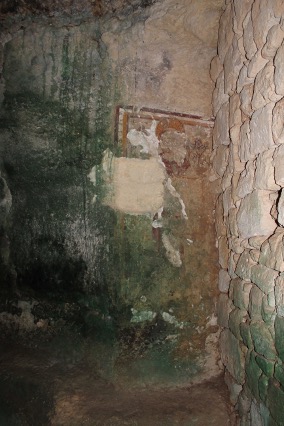
| Courtesy of Martha Borg
The Carmelites drastically altered the cave church. It seems that the church may have originally been bigger and may have had a built facade, with the interior walls stuccoed and painted, evidenced in the remains of painted areas, namely in the apse, and a lime-based mortar. Alterations include a built cylindrical apse made of ashlars and wet rubble containing a stone altar, and a flagstone pavement, in evident emulation of the architecture of aboveground late medieval churches. The rock cut wall benches, or dukkien, seem to belong to the original church. Similar examples of wall benches are seen in cave churches in the vicinity, namely in the Abbatija tad-Dejr and the church of St. Mary Magdalene.
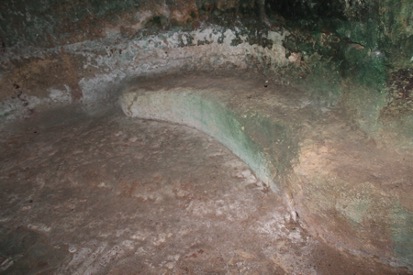
Borg M. The Cave Churches in Malta and their Paintings: An Art Historical Gazetteer. Dissertation for a Degree of Bachelor of Arts (Hons.) in History of Art. (Faculty of Arts. University of Malta). June 2014
5. The Church of Mensija: The “forgotten church”
This underground cave church in the town of San Ġwann, accessed through a 40-step staircase, is intimately linked to a legend, which goes back to the dawn of the 15th century, about an image of the Madonna that was hidden and forgotten for a very long time. It goes that a farmer, Andrea (Indri in Maltese), acquired the land surrounding this cave, where he built a farmhouse. One late evening, on entering his abode, the farmer observed a streak of light piercing the underground stone fissures. Andrea called his family to share this unusual happening. Out of curiosity the whole family started clearing the subsoil. On reaching the bedrock a huge rock dislodged itself, leaving a gaping hole. When they peeped through this opening, they got the surprise of their lives – there was a lit three-wick oil lamp facing a sacred image! So, Andrea entered the cave, grabbed the image and went to the parish priest as fast as he could. The following day the image mysteriously found its way back to the cave.
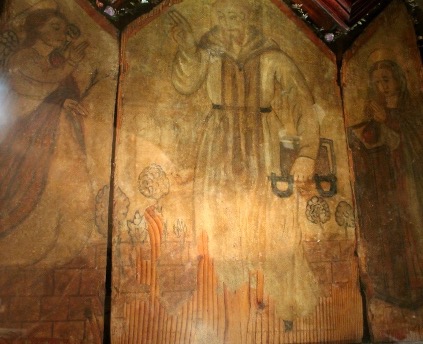
When the image’s relocation failed a second time, the parish priest reported both episodes to the bishop.The latter ordered its delivery to his palace, but once again the image found its way to the cave. Convinced that this was Heaven’s will, the bishop ordered a thorough clean-up of the cave and erected an altar. This extraordinary event spread like wildfire, and people from far and near flocked to the site to show their devotion. In the cave one finds a triptych image of the Annunciation, with St. Leonard in the middle, the Madonna to his left and Archangel Gabriel to his right. Probably this triptych is the image of the legend refers to, however, this is not certain. Today, this sanctuary of the Madonna is still very active, and devotion is extremely fervent. In the sanctuary one also finds many ex-votos for graces granted by the Madonna.
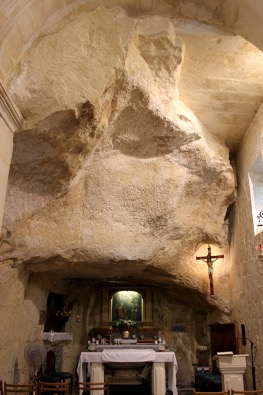
Mousu S. Rediscovering Forgotten Mensija. The administration of the San Ġwann parish church
Spiteri S. Il-Parocca ta’ San Ġwann (The Parish Church of San Ġwann). The administration of the San Ġwann parish church. Malta. 1991
6. Church of the Nativity of the Blessed Virgin in Fort St. Angelo
Behind the protective ramparts of Fort Sant Angelo in Vittoriosa, a colony of Angevins, and later other Catalan and Sicilian nobility, grew steadily. Mariners and merchants from all over Christendom were also part of it. Fort Sant Angelo became known as the Castello a Mare (The Castle on the Sea), or by its Latin name Castrum Maris. A 1274 inventory found in the State archives of Naples mentions two chapels in the Castle, one dedicated to St. Mary, later dedicated to St. Anne, while the other called Sancti Angeli – hence the name Fort St. Angelo (named after the martyr St. Angelo of Jerusalem).St. Angelo was martyred in Licata, Sicily, only 70 miles from Malta. In Malta, the cult of St. Angelo began soon after his death as quite a few residents in the Castrum Maris were from the Licata area.
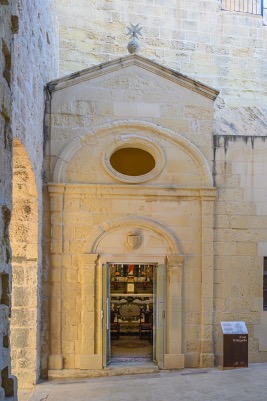
The chapel dedicated to him was carved into the bedrock using troglodytic techniques. Indeed, according to tradition, it was founded in the 11th century. In fact, the 1274 inventory also makes reference to artifacts that were already regarded as antique, implying that they go back to at least the 11th or 12th century. The late Hugh Braun, an authority on medieval architecture, wrote that there is a similarity between this chapel and those of Mellieħa and Saint Paul’s Grotto in Rabat. In the 13th century the chapel of St. Angelo was dedicated to the Mother of God (Mater Dei), specifically to the Presentation of the Blessed Virgin, and subsequently, around 1462, to Our Lady of Perpetual Help, and after to the Nativity of the Virgin.
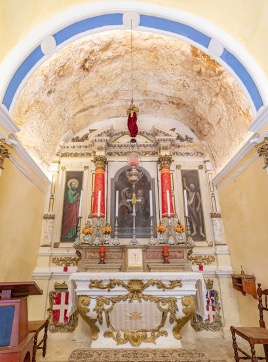
The painting above the altar shows St. Anne holding the infant Blessed Virgin with a Mater Dei inscription at the bottom | Pierre Balzia on behalf of Heritage Malta
Darmanin J.F., “The Phoenico-Graeco-Roman Temple and the Development of Fort St. Angelo”. 1948
Ciantar N., Zahra L.,“Il-Knisja tal-Vitorja – Fil-Forti Sant’ Anglu, Birgu”, in Kappelli Maltin.
7. Church of the Immaculate Conception of Msida
The troglodyte Church of the Immaculate Conception of Msida dates back to a very long time. However, the first time it was officially mentioned was in Mgr. Pietro Duzina’s Apostolic visit, in 1575. At the time this church was dedicated to Our Lady of Perpetual Help. It may be that by 1615, the title was changed to that of the Assumption (Santa Marija). In a report by Bishop Balaguer (compiled between 1656 and 1659), we find that the church was referred to, for the first time, as the Church of the Glorious Immaculate Conception of Our Lady. Unfortunately, like other churches hewn in rock, it did not escape damage by the elements, and had to be repaired and restored several times. But Providence never failed to intervene. Indeed, great benefactors such as the Famucelli Family and Fra Philip Wolfgang, Baron of Guttenberg and Bali of Brandenburg, stood out and contributed heavily to the upkeep of this church.
They also adorned it with great works, some of which unfortunately disappeared. Early in the 19th century, the residential area in Msida grew exponentially and this small church could not accommodate all the worshipers. In 1851, a request was submitted to the Bishop to enlarge the church, which was at first refused. However, in 1867, Msida was elevated to a separate parish, with the Church of the Immaculate Conception as its parish church, but soon after, the present Msida parish church dedicated to St. Joseph was built. The cave church was abandoned, suffered great damages and consequently, closed down in 1907. Subsequently, the people asked for the bishop’s support to restore it; he in turn made an appeal in the local papers for the devotees of the Madonna to finance the necessary restorations. His appeal had the desired effect, and the church was re-opened in 1916. Today, the faithful call the cave church “The Little Church.” The Madonna and Her “little” church are still in their hearts.
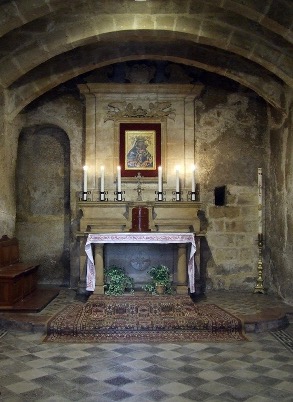
Calleja J. L-Imsida il-Bieraħ u Llum – Vol. 1 Il-Ħajja Reliġjuża Ta’ Raħal (Msida Yesterday and Today – Vol. 1 The Religious Life of a Village). Malta. 1989
Terribile T. Teżori fil-Knejjes Maltin – L-Imsida (Treasures in Maltese Churches – Msida). Malta. 2009
Busuttil R. Il-Kappella tal-Kunċizzjoni – Msida (The Chapel of the Immaculate Conception – Msida). Kappelli Maltin (Maltese Chapels) Accessed February 2021
This content has been brought to you in partnership with the Malta Tourism Authority

